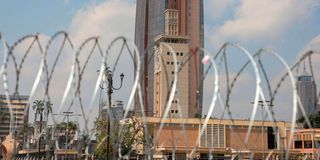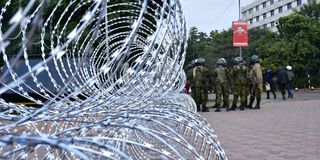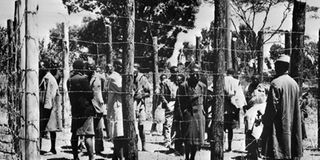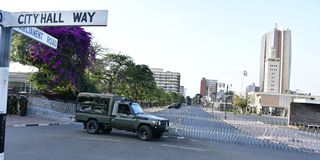
Razor-sharp barbed wire placed on the entrance of Parliament Road on June 25, 2025 during the anti-government protest on June 25, 2025.
On Wednesday, June 25 morning, Kenyans woke up to a striking and chilling sight: Parliament and the road to State House — the symbolic heart of the republic — had been barricaded with coils of barbed wire. The razor-edged fencing, twisted and unyielding, was more than mere infrastructure.
The barricade conveyed a government no longer in dialogue with its people, but at war with the streets that sustain it. In wrapping the seat of power with barbed wire, the state offered a chilling image of an administration shielding itself not from enemies without, but from citizens within.
Barbed wire is never neutral. Invented in 1874 by Illinois farmer JF Glidden to manage livestock, barbed wire was a brutal innovation in fencing. Its sharpened steel barbs inflicted pain on livestock to ensure compliance.
But what began as an agricultural tool quickly found darker applications in human history when it was turned into a tool for warfare, mass internment, racial segregation, political suppression and in marking borders. Thus, barbed wire is today more than a method of crowd control or spatial demarcation. It is saturated with historical memory — raw, political and deeply psychological.
On Wednesday in their haste to secure so-called “protected areas,” the Kenyan police — under the command of Inspector General Douglas Kanja — may have unwittingly dragged the country back into a history marked by domination, exclusion, and state violence.
What was likely intended as a routine security measure to keep Gen Z protesters at bay, instead summoned a haunting visual language long associated with repression. Barbed wire, more than water cannons or tear gas, remains a potent symbol of control, one that previously defined the architecture of colonial rule and its violent aftermath.

Razor-sharp barbed wire at the entrance to Parliament Road on June 25, 2025.
By deploying such symbols in the heart of the capital, the state did more than block access. It resurrected the visual grammar of colonial control, recalling an era when space was policed not for the safety of citizens, but for the convenience of rulers.
It is rare in a democracy to barricade Parliament with barbed wire —for such an act sends a powerful and unsettling message. Throughout history, totalitarian regimes and colonial powers alike recognised the utility of barbed wire as a tool of control and intimidation. That Douglas Kanja has now turned to this instrument — whether knowingly or naively — suggests a troubling lapse in judgment, one that blurs the line between security enforcement and authoritarian impulse.
Let me give an example. In Nazi Germany, barbed wires defined the perimeter of horror by encasing Auschwitz, Dachau, and Treblinka in electrified steel, separating the condemned from the world. In Joseph Stalin’s Soviet Union, the gulags were bound by it, transforming the Siberian wilderness into a network of cold suffering. The barbed wire marked not just territory, but the abandonment of rights, dignity, and dialogue.
When Joe Biden erected razor wire around White House during his inauguration, one Congressman Andy Biggs said “it’s not appropriate for the American people to be walled off from their elected representatives in the People’s House.” Back in colonial Kenya, barbed wire took on a similar function during the Mau Mau uprising of the 1950s.

In a file picture taken in October 1952 soldiers guard suspected Mau Mau fighters behind barbed wire in the Kikuyu reserve at the time of the Mau Mau uprising against British colonial rule in Kenya. PHOTO | AFP
The British colonial authorities transformed entire communities into prison camps by erecting barbed wire fences around them. Under the euphemism of “protected villages,” over a million Kikuyu, Embu, and Meru civilians were forcibly relocated into the fortified settlements. These were not villages in any meaningful sense. They were militarised zones, surrounded by barbed wire, spike-filled trenches, and patrolled by armed guards and loyalist home guards. Movement was restricted, livelihoods were severed, and entire families were detained—without charge, without trial, and with little recourse.
In essence, barbed wire was central to the British system of mass detention. It enabled the colonial state to criminalise entire populations under the guise of counterinsurgency. Its purpose was not protection, but control. It served to isolate, intimidate, and ultimately break the collective spirit of resistance. The “protected villages” were, in reality, open-air prisons designed to dismantle Mau Mau networks by cutting them off from their civilian support base.

Razor-sharp barbed wire at the entrance to Parliament Road.
So, when barbed wire reappeared this week in the heart of Nairobi, it didn’t just interrupt traffic — it resurrected memory. For many Kenyans, especially those whose families were herded into those colonial enclosures, the image was haunting. It revived buried traumas. It recalled a time when barbed wire was not merely a security measure, but a tool of domination — used to contain Black bodies, to suppress political consciousness.
More troubling, the steel coils remind us that the architecture of fear — first engineered by colonial powers — remains intact. The very tools once used by empires to subjugate are now being redeployed in postcolonial democracies, cloaked in the language of maintaining ‘law and order.’
This repurposing of colonial instruments reveals an uncomfortable truth: postcolonial states often inherit not just the infrastructure of empire, but also its instincts. When elected governments deploy barbed wire to barricade Parliament and State House, they mimic the very gestures of empire while cloaking themselves in the language of the republic. The result is a chilling visual contradiction: a democratic government defending itself from its own people.
As we saw around Parliament, barbed wire does more than demarcate space. It transforms civic space into contested territory. It recasts protestors as intruders, turns citizens into threats, and reframes democracy as a security risk. It is not simply a barrier—it is a message. And that message is clear: “This space is no longer yours.”
As historian Reviel Netz observes, barbed wire is a form of “low-cost violence.” It doesn’t require bullets or batons to inflict harm. It deters through the threat of pain, through the spectacle of control. It enforces submission at a distance, replacing dialogue with deterrence. That is its genius — and its danger. It allows the state to rule not through persuasion or participation, but through intimidation and exclusion.
Indeed, barbed wire is a form of spatial politics. It redraws the map — not only in physical terms but in moral and political ones. It separates the powerful from the powerless, the governors from the governed, the state from the street. In a functional democracy, institutions such as Parliament or State House are meant to be open symbols of public accountability. But once enclosed in wire and guarded by riot police, they begin to resemble bunkers of authoritarian retreat.
This phenomenon is not unique to Kenya. In Brazil, private police forces routinely deploy barbed wire to protect elite neighbourhoods from the poor. In apartheid South Africa, razor wire formed part of the architecture of racial separation. Across the globe, barbed wire appears wherever power seeks to entrench itself against perceived disorder. But in liberal democracies, it is usually hidden or avoided entirely because the open use of barbed wire on public streets is a sign of democratic backsliding. It signals a government that no longer trusts its citizens — and, perhaps more dangerously, no longer believes it must.
Thus, when police rolled it out in Nairobi, the barbed wire was the focus of journalists for it spoke the language of exclusion, fear, and pain. It tells the citizen: you are not welcome beyond here. You are not trusted. You are a problem to be managed, not a partner in governance. And that is the greatest betrayal of all — for in democracy, the people are not outsiders. They are the sovereigns.
Ultimately, barbed wire is cartography. It draws lines — between rulers and ruled, between democracy and dictatorship, between a state that listens and one that fears. And in Kenya, as elsewhere, it compels us to ask: whose space is being protected? Why must the public space be defended by spikes and steel?
What am I saying? When governments barricade themselves from their own people, it is not the citizens who have failed the state. It is the state that has failed the citizens.
Kamau is a PhD candidate at the Department of History, University of Toronto, Canada. Email: [email protected] @Johnkamau1






